The garage is a real home for the car, protecting the car from the negative effects of rain, snow, moisture and dirt. Here you can repair the car, store spare parts, tools or things that are unnecessary in the apartment. In order not to depend on weather conditions and the season, many owners seek to insulate the gates in the garage, because they are the main cause of heat loss. You will find recommendations and tips for insulating garage doors with your own hands below.
Of course, there are many reasons to insulate the gate, we will give only the most obvious ones:
Garage door insulation solves a number of reasons for both summer and winter. In the photo - insulation with polyurethane foam.
- In the summer, the metal sheets of the gate, heating up in the sun, heat up the air in the garage so that it becomes impossible to stay there. And in winter, frost penetrates through the cracks, lowering the temperature to the street. Repairing in such conditions is simply unhealthy.
- If heaters are used in cold weather, then in order to maintain the temperature and conserve heat and electricity, it is necessary to insulate the garage door.
- A properly insulated garage will have lower humidity and less condensation, which can lead to corrosion of the car body. The microclimate of the room becomes softer and devoid of temperature fluctuations.
Is it possible to insulate my type of gate?

Insulation of metal garage doors can be done independently
If you have hinged steel gates installed, as in most garages, then they can and should be insulated. After all, the material of the sheets and the frame is ordinary steel, which reacts to any temperature fluctuations. Work on the insulation of the gate from the inside can be done by hand.
The right insulation is the key to success
Important! Insulation is a material with low thermal conductivity. The thermal conductivity of a substance is expressed by the coefficient of thermal conductivity. The lower the coefficient, the better the insulation performs its function. As the thickness of the material increases, its efficiency increases. However, for garage doors, five centimeters of thickness is enough. .
There are a wide range of garage door heaters on the market. How to understand all this diversity? It is best to properly understand the main types, because not everyone is suitable for your case.
- Foam plastics are synthetic foam materials based on polymers.

Styrofoam is an easy-to-use material
Polystyrene foam - perhaps the most famous type, looks like connected white balls. Excellent for insulating gates due to its lightness, minimal hygroscopicity, strength and fire resistance. Sometimes called Styrofoam.
Urea-formaldehyde foam is also often used in heat and sound insulation. Has the property not to swell when solidified. Suitable as a heater for garage doors.
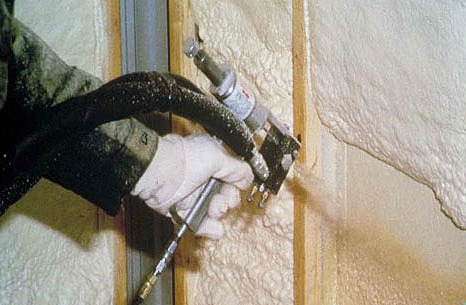
Sprayed polyurethane foam - an effective heat insulator for gates
Polyurethane foam is divided into two varieties. The first is ordinary foam rubber, and the second is polyurethane foam. In thermal insulation, the latter option is used. The foam has excellent thermal conductivity properties and even serves as a waterproofing agent. It is sprayed onto the surface, filling the cavities. An excellent material, however, the cost of application work may be a reason not to choose this material.
- Mineral wool - a material used in construction, has three subspecies: glass wool, slag wool and stone wool. The use of mineral wool is limited due to hygroscopicity.
Glass wool consists of the smallest glass particles and has a low thermal conductivity: 0.03 - 0.05 W/m*K. Care must be taken when working with this material.
Slag wool is produced from metallurgical residues (slag). The thermal insulation of the material is slightly worse - 0.04-0.05 W / m * K, which does not diminish its popularity in construction, however, it will not work to sheathe the garage door - the material does not get along well with steel.
Stone wool is made from rocks. Thermal conductivity - 0.03-0.04 W / m * K. It is also not suitable for insulating garage doors, as the material releases toxic substances when heated.
The first stage: surface preparation and creation of the crate
- Even before starting work, it is worth working out the ventilation system of the garage. There must be supply and exhaust openings. If there is already a supply air at the gate, it is important not to close it with a layer of insulation.
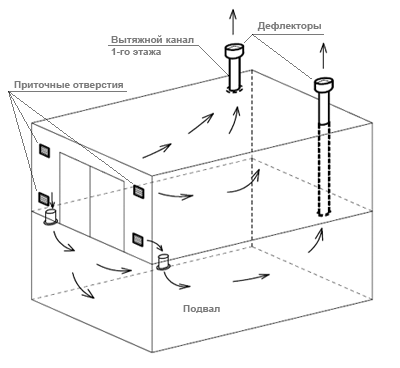
- It is important to treat the surface of the gate by cleaning the corrosion with a brush or grinder. Insulation may interfere with, for example, peeling paint. After stripping and peeling off the paint, it is necessary to treat the metal with an anticorrosive agent. It will come out better if you apply a layer of primer from the sprayer.

- The next step is the process of making the crate. It helps to fix the insulation, and the outer, front layer of the cladding will hold on to it. It is optimal to use 4 * 4 cm bars for the crate, about the same size. The crate is attached to the frame of the gate. The wood must be dry and of good quality. The bars are treated with an antiseptic against rot and moisture, it is advisable to do this twice. To fix the beams in the frame, a hole is drilled for the self-tapping screw. It is important to make notches in the crate for openings in the gate. The bars can also be fastened together if there is no rigid frame.

Second stage: insulation using various materials
Foam insulation
- When using PSB-styrofoam, waterproofing methods must also be used. And you can sheathe EPPS, which does not absorb moisture. Such panels are more expensive, but do not require insulation. To fix the foam on the surface of the gate you need:
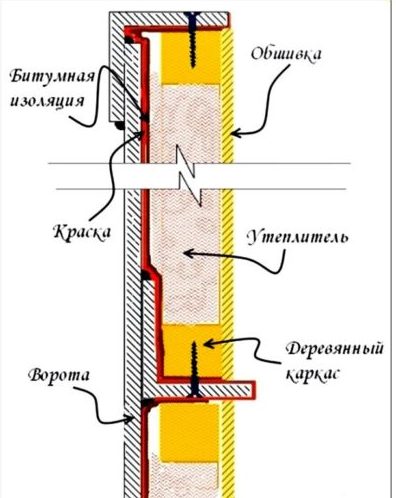
- It is necessary to cut the foam sheets, measuring 2-3 mm more than the size of the cells of the crate, this is done for a tighter fit of the insulation. Ideally, the number of joints between sheets should be minimal.
- The insulation can be attached with mounting foam, it is better if it does not greatly increase in volume when it dries. Foam is applied to the back side of the foam at the edges and in the middle and the sheet is pressed as tightly as possible against the gate. Within half an hour, a more accurate fit of the insulation is performed.
- When the sheets are attached to the gate, it remains only to fill the joints with foam. After the mounting foam has dried, it is necessary to get rid of the protruding excess, which is easy to do with an ordinary knife.
Warming with mineral wool
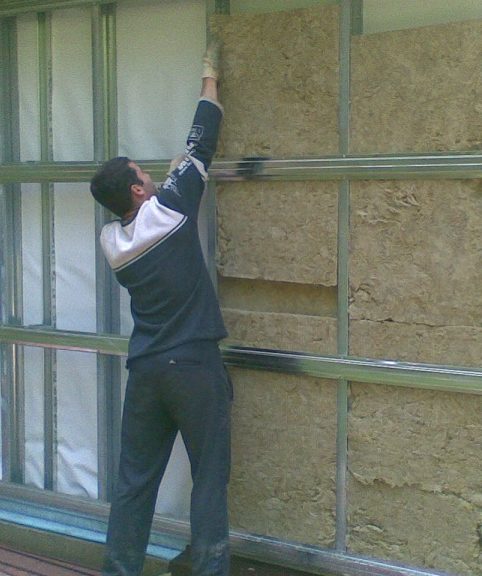
The use of mineral wool when insulating garage doors is quite acceptable. But in comparison with the foam fixing technology, mineral wool is more demanding on surface preparation. So, due to the hygroscopicity of the material, it is necessary to treat steel surfaces with bituminous mastic or isolon.
After carrying out waterproofing measures with sashes, you can start cutting mineral wool into pieces of the desired size. It is necessary to achieve the tightest fit of the insulation fragments to the crate and to each other, since the mineral wool has a tendency to caking. Next, a vapor barrier film is attached over the insulation so that the inner side is not exposed to moisture.
Insulation with polyurethane foam
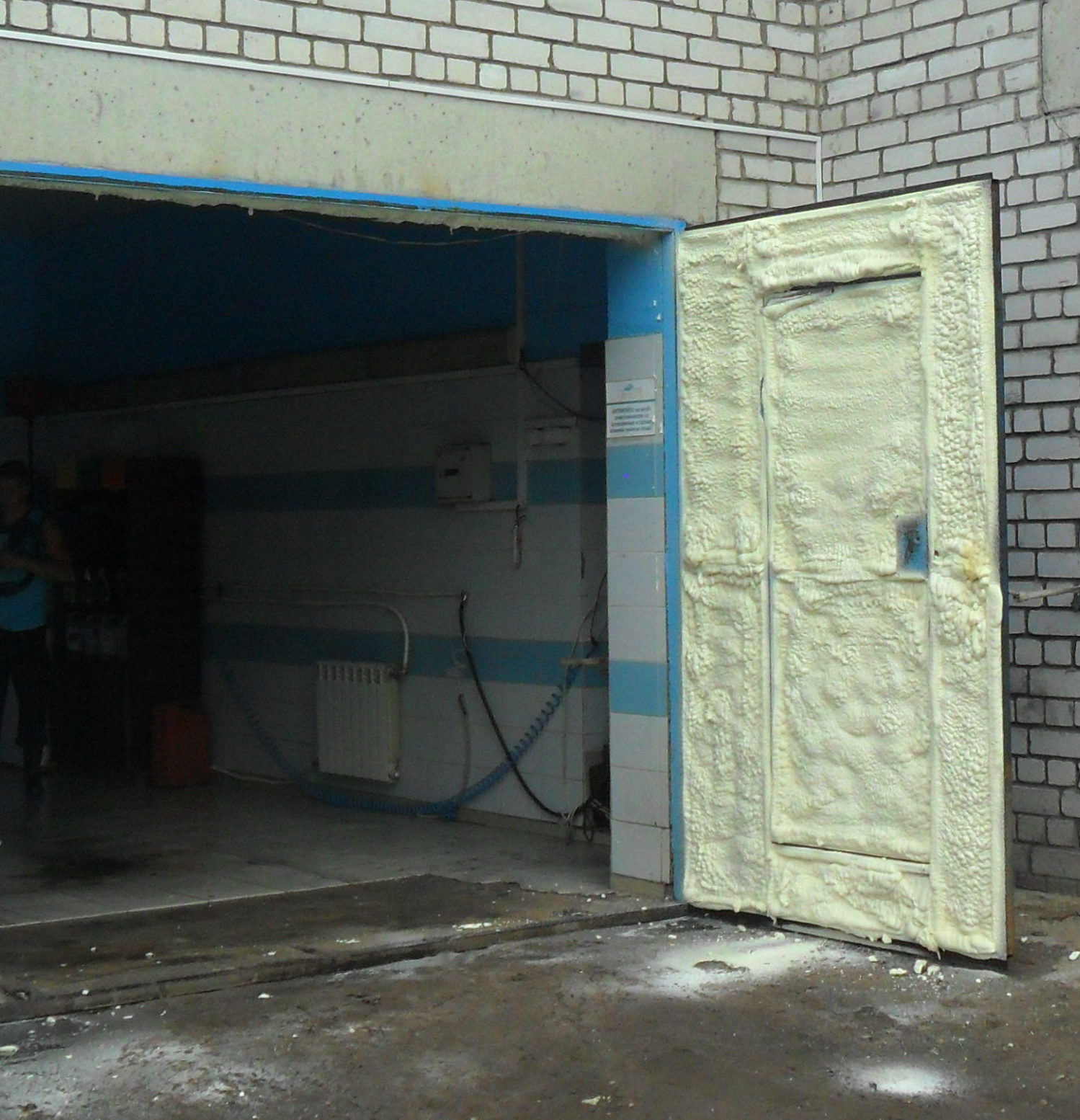
Garage door insulation with polyurethane foam - the fastest way
In this case, you should also take care of the crate, as it will be needed for facing the gate. A special spray technique is used to apply polyurethane foam, so you need to find a company that provides application services. Before covering with this type of insulation, it is necessary to seal those openings and gate parts into which foam is undesirable. During the application process itself, protection of the mucous membranes from the harmful vapors of polyurethane foam in the raw state must be used. When the insulation completely hardens, it will become harmless to humans. Some advantages of using polyurethane foam:
- Thermal conductivity coefficient 0.019—0.035 W/m*K. This is an order of magnitude better than mineral wool or polystyrene.
- Excellent cavity filling.
- Durability - service life of about 60 years.
Third stage: finishing facing
When the insulation work is completed, there is a reasonable desire to make high-quality cladding. Since there is a wooden crate between the sheets of insulation, this is not difficult to do. How to sheathe garage doors? There are several widely used options:

- Decking
- Plastic panels
- clapboard
- OSB sheets
Advice. You can fix the cladding with both a construction stapler and self-tapping screws.
Sealing the sashes - the finishing touch in the process of insulation
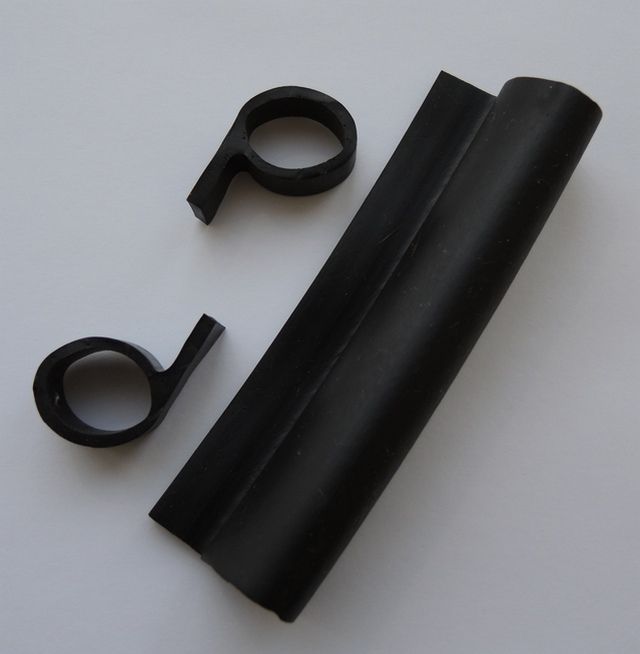
Often, measures for laying insulation are not enough to keep warm - heated air is blown out through the slots in the wings. This problem is easily solved by using a garage door seal. A hollow rubber strip with a round section, resembling a hose, will do. It is attached to a special tail, which is fixed with a strip of metal and self-tapping screws.
Advice. The bottom of the flaps cannot be insulated with a sealant, however, heat loss can be reduced by using a brush profile. It is also mounted with self-tapping screws.
Video: a budget way to insulate garage doors
Conclusion
Warming the garage door is not an easy, but necessary process, because it should be comfortable for both a person and his car to be in the room. The most optimal way of insulation today is polyurethane foam insulation. This is the most effective material in terms of its characteristics. At the same time, it is much more convenient to improve the microclimate in the garage with your own hands with the help of foam. What exactly to use, whether to do the cladding, only the owner decides. We hope this article was helpful to you.



